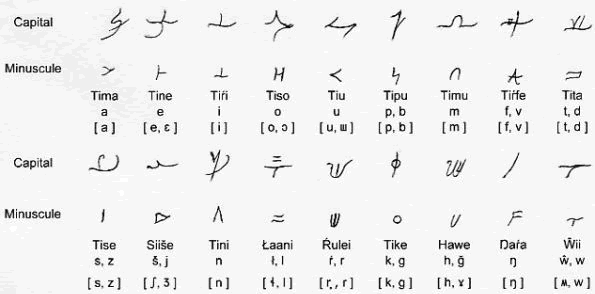
The Šsioŵe Łuŵuŕ alphabet was created in 2006 by Jacob Collard. The alphabet began as an alternative script for English that was meant to be very compact but still easy to learn. However, the alphabet was later used for writing a conlang that Jacob had been writing, and has rarely been used for English since. The language has become the basis for a book that Jacob has been writing, which currently has no definite title. The basis for the compact writing is a square which can hold five or six letters depending on the first, therefore using space more efficiently.
The cell structure is, in Šsioŵe Łuŵuŕ, the way that the letters combine into five-letter groups. One group is called a cloister and one space that may hold a letter is called a cell.

There are also four digraphs: 'io' and 'ea' are pronounced as [ɪ] and [æ], respectively. 'Th' and 'dh' may be pronounced as either aspirated alveolar plosives or as dental fricatives, i.e. [tʰ] and [dʱ] or [θ] and [ð].

The 'X' shown represents any cloister.
There are four basic diacritics in Šsioŵe Łuŵuŕ, all of them based on a curved stroke. All of them perform the same function, which is to make a voiceless sound voiced, but they each affect a different cloister in the cell. The primary diacritic voices the first cloister, the secondary voices the second cloister, the tertiary the third, the quaternary the fourth, and the quinary the fifth. There is also a senary diacritic, which voices the sixth cloister. The senary diacritic appears the same as the primary except with a vertical line through the center.

Anam’Aŋ Ełie Šsioŵe Thorn Ši Eałan E Teŕe T’ Tam Tamawe Kŵu Peath Emis Šsioŵe Wu Elewi Eałan F’ Ŕin Tała Poŕau Anam’Aŋ Ši Dhoše M’ Thorn Ts’ Šsioŵe Ts’ Elewi Mai Kŵu Šsioŵe Thorn In Haian’Aale Unum’Uŋ Thorn Šeŵi Me Ełie Ts’ Mi Wu Elewi Mai Elewi
All human beings are born free and equal in dignity and rights. They are endowed with reason
and conscience and should act towards one another in a spirit of brotherhood.
(Article 1 of the Universal Declaration of Human Rights)
If you have any questions about the Šsioŵe Łuŵuŕ alphabet, you can contact Jacob at: jacob@rsgohio.com
Constructed scripts for: Ainu | Arabic | Chinese languages | Dutch | English | Hawaiian | Hungarian | Japanese | Korean | Lingala | Malay & Indonesian | Persian | Tagalog / Filipino | Russian | Sanskrit | Spanish | Taino | Turkish | Vietnamese | Welsh | Other natural languages | Colour-based scripts | Tactile scripts | Phonetic/universal scripts | Constructed scripts for constructed languages | Adaptations of existing alphabets | Fictional alphabets | Magical alphabets | A-Z index | How to submit a constructed script
[top]
You can support this site by Buying Me A Coffee, and if you like what you see on this page, you can use the buttons below to share it with people you know.

If you like this site and find it useful, you can support it by making a donation via PayPal or Patreon, or by contributing in other ways. Omniglot is how I make my living.
Note: all links on this site to Amazon.com, Amazon.co.uk
and Amazon.fr
are affiliate links. This means I earn a commission if you click on any of them and buy something. So by clicking on these links you can help to support this site.
[top]